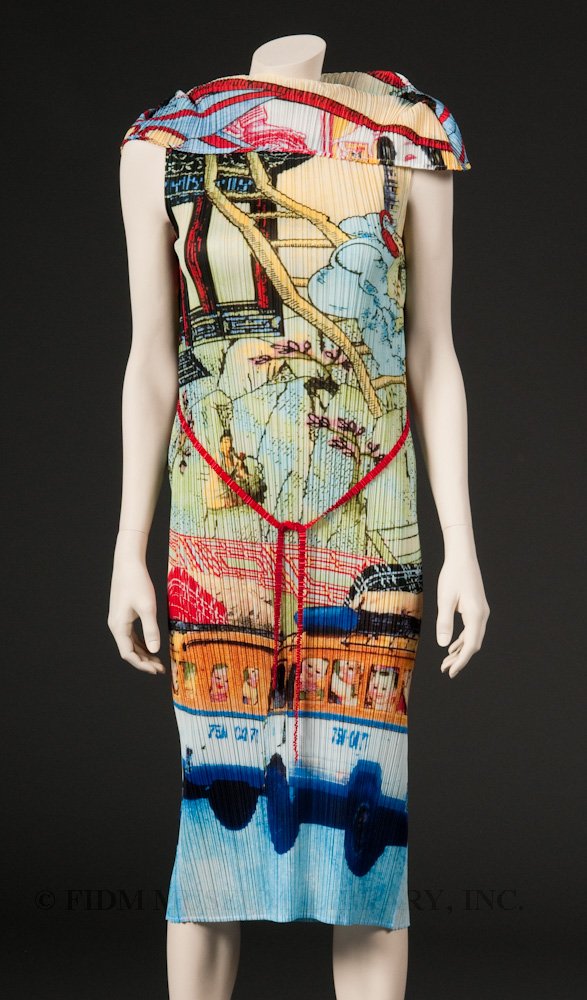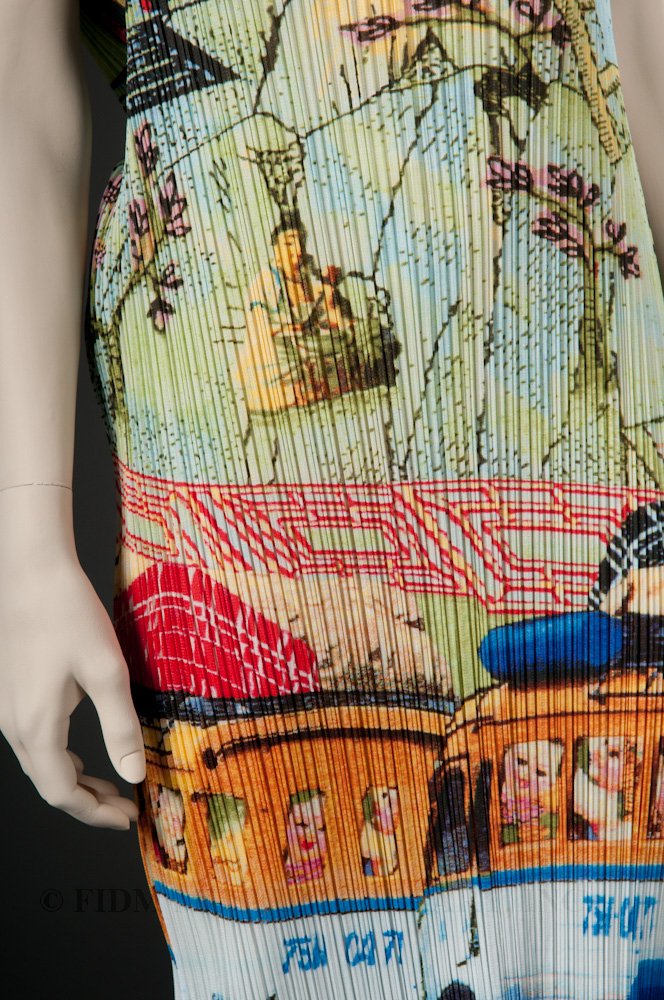The concept of Issey Miyake's Pleats Please line is simple: timeless, wearable garments that require minimal care and maintence. As the name of the line suggests, the distinguishing feature of the Pleats Please line are the pleats. Unlike most pleated garments, wherein the pleats are created as part of the construction process, Miyake's pleats are created in a process separate from the joining of seams. Garment pieces are cut 2 1/2 to 3 times the desired size and then sewn together. The oversize garment is then placed between two sheets of paper and run through a heat-set pleating machine. Because Pleats Please garments are constructed from a polyester textile, the resulting mushroom pleats are permanent, holding their shape even through the wash cycle. When the line was introduced in 1993, Miyake noted its hearty character, calling it " 'anti-static, perspiration-absorbent, anti-stain and fast-drying.' "1
 Issey Miyake
Issey Miyake
Pleats Please
c. 2000
Gift of Elizabeth Galindo
2008.886.1
Given Miyake's well-known interest in architectural garment shapes, "timeless" might seem like a misnomer. In fact, Pleats Please garments are timeless because they are exactly the opposite of fast fashion. Consisting of basic garments (dresses, shirts, skirts, pants) meant to be worn interchangably, the basic form of a Pleats Please garment is largely the same today as it was when the line was first launched. To keep the line from getting stale, new colors and patterns are regularly introduced. Usually, the patterns are printed on the fabric before pleating, so the image itself is textured and dimensional. Like the pleated silk gowns of his stylistic predecessor Mariano Fortuny, the consistently simple, unstructured shapes of Miyake's pleated garments help them maintain a position outside the rapid turnover of the fashion cycle.
Many Pleats Please garments are solid color, relieved only by the textural interest of the pleats. Somehow, the solid colors convey an impression of seriousness. When printed with patterns, Pleats Please garments somehow become lighter and more playful. The pattern seen on this dress, a mash-up of temple gates, cherry trees, a seated Buddha and playful children is particularly light-hearted. It may have been a limited edition Pleats Please dress designed to commemorate the turn of the millenium, though we haven't been able to confirm this fact. This particular dress is unusual in its pairing with a narrow, pleated belt.
Like Fortuny's pleated silk dresses, Pleats Please garments are flat, two-dimensional forms until worn on the body. When worn, the body itself gives a Pleats Please dress three-dimensional structure, shape and form. This interaction between body and garment was highlighted in the Pleats Please Guest Artist Series. Between 1996-1999, Miyake invited four artists to create images for printing on Pleats Please garments. Three of the artists (Yasumasa Morimura, Nobuyoshi Araki, Tim Hawkinson) used imagery of the body, either in its entirety or selected portions. The forth artist (Cai Guo-Qiang) used gunpowder to burn a pattern into a white Pleats Please dress. By placing art on garments, Miyake side-stepped the question as to whether fashion is art. Instead, he created a new relationship between artist, wearer and designer, each of whom brought something essential to the final product.
1 Spindler, Amy M. "Patterns." New York Times 31 Aug. 1993: B6.



I love this dress. My thin alter-ego yearns to own it. It just looks so fluid…like it would really make the wearer seem lively and cheerful.
Interesting dress design with various colours interaction.